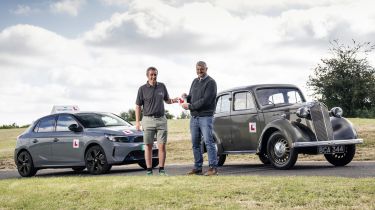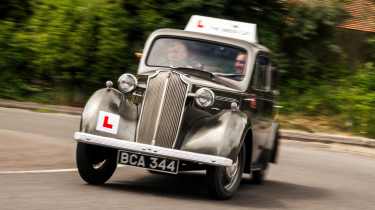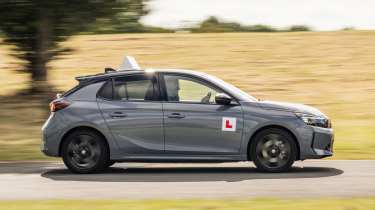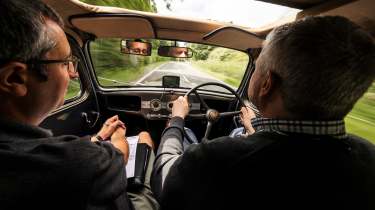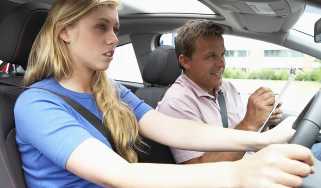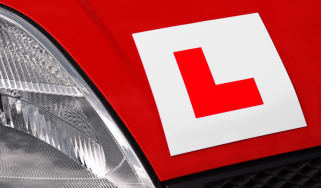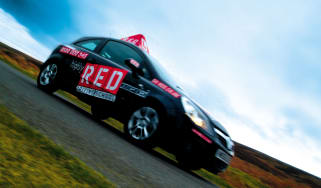Old driving test vs new driving test: we take both in a day
We compare the changing challenges faced by learners by taking the original driving test in a modern Vauxhall Corsa - and today’s equivalent in a 1930s classic
We’ve been asked to do some pretty silly things in the name of journalism, but there’s usually an explanation provided. We’re still not sure why Vauxhall thought we should attempt the original driving test from 1935 in the latest Corsa Electric, though.
And what would 1930s candidates have made of the challenges faced by learners today? We’d soon find out, because we agreed to do the old test in the new car – if Vauxhall found us an old car to take the current test.
The firm couldn’t quite manage a 1935 model, but it got close with the 10-4 from 1937, now looked after by staff at the National Motor Museum in Warwickshire.
It’s a pretty four-door saloon from an era that was, for Vauxhall, golden. Much as the Corsa Electric benefits from PSA and Stellantis technology, the 10-4 was built using GM cash and some of its tech, including patented Dubonnet independent front suspension. The Vauxhall also boasted up-to-date features such as all-round hydraulic brakes, full synchromesh on the gearbox, and perhaps most significantly, monocoque construction.
It was the first British mass-produced car to be built this way – and very advanced for its day. Contemporary reviews suggest the 10-4 was widely considered to be the best small car around, while Vauxhall bragged about its ‘million pound motorcar’ due to the whopping sum spent on its development. Even at the princely price of £159, it broke sales records for the firm, before production stopped to make way for tanks in WWII.
You’d have to have been reasonably well off or highly motivated to own a car between the wars, and the same could be said today of anyone buying an electric Corsa. It’s the firm’s smallest car, but this is some way off being the cheapest variant; a 1.2-litre petrol model can be had for £18,500, while the electric car starts at almost £27,000. Meanwhile, £159 in 1936 translates to only £14k today, according to the Office for National Statistics, making the electric Corsa roughly twice the cost of the old 10-4.
It’s probably not fair to ask which of the duo is prettier, but it is worth mentioning safety. Apart from the Corsa’s array of driver aids, its body is one big safety cell. But the thick windscreen and B-pillars come at a price; the Corsa isn’t great to see out of. It’s even harder to get out of, at least if you’re over six feet tall; pushing the driver’s seat back and pulling the steering wheel out for a comfortable driving position leaves barely any room to exit via what seems to be a very pinched door aperture.
Rear-hinged doors on the 10 make getting in and out a breeze, but for all the delights of the classic model’s airy and comfortable cabin, you wouldn’t stand a chance hurtling sideways into a lamp post. And they’re called ‘suicide doors’ for a reason, due to the numbers of casualties dragged out of moving cars when the wind caught a door opened deliberately or by mistake; back then you weren’t held in by a seat belt, either, of course.
Which gets us, in a roundabout way, back to the driving test. It was implemented in 1935 to try and turn the worrying tide of deaths and casualties associated with the rapid rise in the number of private cars on the roads. In 1920 there were fewer than 120,000, but by the end of the 1930s there were nearly 1.5 million, not to mention legions of commercial vehicles, with the result that road fatalities were up to as many as 7,000 a year.
Action was called for, and not the controversial decision to abolish maximum speed limits taken in 1930 – the last hurrah of an upper-class motorist lobby fed up with being hauled over the coals by working-class police constables who didn’t know their place. Sense prevailed reasonably swiftly, and speed limits made a comeback on UK roads in 1934, a move preceded by the introduction of the Highway Code in 1931, and followed by the driving test, which became compulsory for new drivers in 1935; previously, licences were issued by local councils on request. Incidentally, right up until the late 1950s licences had to be renewed annually, and then every three years until 1976, when licences became valid until a driver reached the age of 70.
History records the first person to pass the UK test was Ronald Beare of Kensington, who paid seven shillings and sixpence for the privilege – equivalent to £25 now.
Today, I’m aiming to become possibly the first person to pass the original and current driving tests on the same day. But I’ll be taking mock exams, because I passed the real thing back in the 1980s. At the first attempt, of course…
Standing in for the Man from the Ministry, or person from the Driver and Vehicle Standards Agency as we know them today, is Alex Doyle, an officially accredited driving instructor who operates the Green Cat Driving School in Southport, Merseyside. He’s an experienced instructor with EV experience, and luckily has also been studying a reprint copy of the original Highway Code.
Even more auspiciously, he’s brought it with him, so I can have a squint at some of the more arcane practices and actions expected from drivers in the 1930s, before my technique is scrutinised. While some of it seems outlandish these days, the opening paragraph rings just as true in 2024 as it ever did: “Always be careful and considerate towards others. As a responsible citizen you have a duty to the community not to endanger or impede others in their lawful use of the King’s Highway.”
We’re doing the 1930s test first, so that means jumping into the Corsa, which is great because, never mind electric drivetrains, electric windows are a revelation when you’re expected to use hand signals before manoeuvring. Although these were removed from the driving test in 1976, they were still firmly part of the average driver’s consciousness when my career on the road started, so I have a bit of an advantage. Nowadays, they’re rarely used even by cyclists, who have no other means of indicating direction changes, but back in the 1930s drivers had to expect questions on the whole gamut of signals given by drivers, police controlling traffic, and even coachmen using their horsewhip to warn of an impending manoeuvre.
On the plus side, there were far fewer road signs the examiner could quiz you on, while the emergency stop and hill start remain in the test to this day – although there’s just a one-in-three chance you’ll be asked to perform one now. Either way, they’re tasks the Corsa makes light work of, thanks to the benefits of hill-hold and anti-lock braking. The classic three-point turn would certainly be more challenging without the benefit of parking sensors and
a reversing camera, because visibility is not the Corsa’s greatest strength. But I still manage to earn a debit point as my wheels hit the kerb in a simple lapse of attention.
We return to the ‘test centre’ – the car park at the British Motor Museum at Gaydon – with my pride largely intact, and switch straight into modern test mode in the 1930s classic. Thankfully my examiner assumes I’ve cleared the theory test, because I know there are road signs in the modern Highway Code I can’t name without a prompt.
The hill start proves the trickiest technique to master, requiring judicious use of throttle, clutch and handbrake, but I get away without much more fuss than I’d expect in a modern manual car, although it feels more dramatic than the Corsa’s smooth progress. Disappointingly, the three-point turn no longer figures on the test agenda, but the Vauxhall 10’s light steering and advanced synchromesh gearbox make light work of the challenge of bay and parallel parking, as well as pulling up on the right, reversing, and rejoining the traffic.
After all that, it’s time to settle down and enjoy a bit of thoroughly engaging ‘do-it-yourself’ driving, while following the sat-nav. The modern test insists this should be a Garmin-type device stuck on the windscreen that manages to look incongruously ‘old school’ even in a classic car.
Returning to base, and having first confirmed that Alex is going to issue a brace of mock test ‘passes’ so we’re still on talking terms, there’s time for a chat about the experience.
While he feels there’s much about the safety focus in the original test carried through to today, it was certainly easier and shorter. Alex also feels there was a lot more focus on car control than is required today, and like me he enjoyed the all-round view from the old car. “The visibility was so much better, so I think manoeuvrability was actually better in the old one,” he said. “And that’s taking into account how clunky the clutch is, and the turning circle and stuff. From an instructor’s point of view, I knew exactly where you were positioned in that car, but the Corsa I was a little less comfortable with. We drive these modern cars every day, so we know the width of them – I didn’t know the other one, but I could see it.”
On the other hand, Alex tells us, the comparison did reinforce the value of modern technology to help with reversing, and indeed the value of door mirrors.
However, looking ahead to the next iteration of the test, Alex thinks there’s a need to change with the times. “From a learning point of view, EVs are really straightforward. It’s like a big mobile phone, so younger generations get it really quickly. But the 1935 test was all about car control, whereas EVs are a more synthetic experience. You’re very insulated from the outside world and it’s quiet even at speed, and I worry people may not appreciate that as they should, because the speed is still very real,” he says.
There are also gaps in the testing syllabus, leaving instructors to fill in the gaps: “Regen brakes are not mentioned anywhere, nor how and when the brake lights come on when decelerating, and that stuff’s important. Lane-keep assist can be dangerous, if a learner crosses a white line for a legitimate reason and the car pulls them back, and that can scare people.” Alex also points to ‘false alarms’ from the autonomous brake system slamming on the stoppers unexpectedly, and traffic-sign recognition systems giving inaccurate info as problematic. “That’s for me, as well as the learner who wants to understand what’s happening, when I can’t give an answer,” he says.
But overall, Alex is pretty upbeat about the UK test regime. “I think the test is actually really robust.” he says. “There’s a reason the pass rate has stayed consistent for 30 years. It’s because it’s challenging, and it should be.”
From our perspective, an afternoon with Alex proves an EV makes lighter work of those test-day challenges. But it also highlights just what new learners could be missing out on if they skip the manual test and go straight for EVs/auto. Sad to remind ourselves, perhaps, because it’s fun.
Click here for our list of the best first cars for new drivers...
Find a car with the experts

